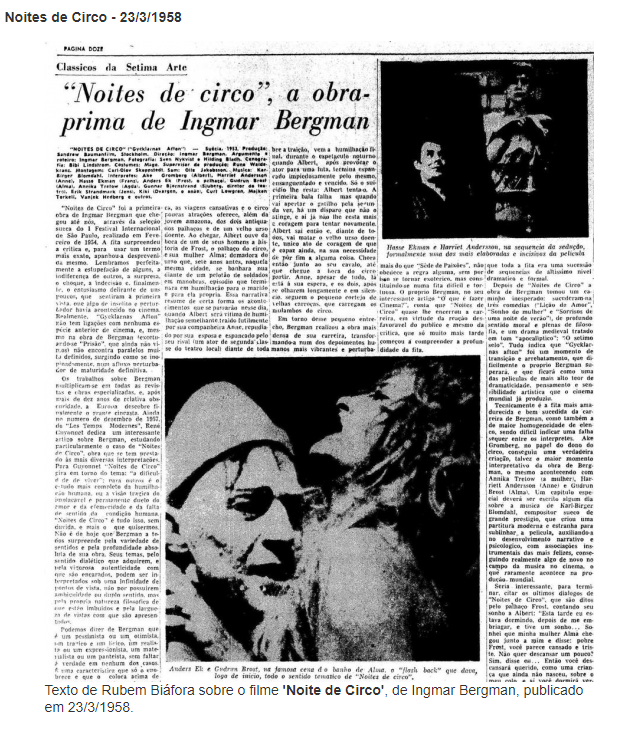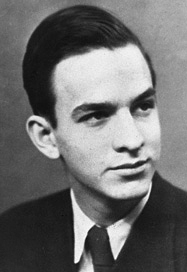23rd March 1958 - OESP cinema columnist gives a little background on Ingmar Bergman's 'Gyclanas afton' (Sawdust and tinsel) or 'Noites de circo' (Circus'nights) in Portuguese - which was first introduced in Brazil at Sao Paulo's 1954 Film Festival.
Ruben Biáfora, the columnist says Brazilian movie buffs were greatly impressed by the Swedish film but conveniently 'forgets' to tell the US delegation visiting Sao Paulo in 1954, gave strict orders that they would not accept 'Gyclanas afton' as the Winner of the Festival. The Brazilian organizers simply kowtowed and submitted to the Yankees' wishes as usual and gave the glittering prize to the run-of-the-mill 'The Glenn Miller story'.
Ruben Biáfora, the columnist says Brazilian movie buffs were greatly impressed by the Swedish film but conveniently 'forgets' to tell the US delegation visiting Sao Paulo in 1954, gave strict orders that they would not accept 'Gyclanas afton' as the Winner of the Festival. The Brazilian organizers simply kowtowed and submitted to the Yankees' wishes as usual and gave the glittering prize to the run-of-the-mill 'The Glenn Miller story'.
6 April 1958 - Ingmar Bergman's 1954 production 'En lektion i karlek' (Lição de amor) reviewed by OESP columnist.
4 May 1958 - OESP cinema columnist is all excited about having watched Bergman's 'The Seventh Seal' (Det sjunde inseglet) in Paris. Set in Denmark during the Black Death, it tells the journey of a medieval knight (Max von Sydow) and a game of chess he plays with the personification of Death (Bengt Ekerot), who has come to take his life.
25 May 1958 - As early as May 1958, Brazilian cinema-directors like Walter Hugo Khoury tried to emulate the Swedish director of 'Glycanas afton' with 'Estranho encontro'.
12 August 1959 -
14 August 1959 - Rio de Janeiro's 'Correio da Manhã' review of Bergman's 'Sommarnattens Leende' (Sorrisos de uma noite de verão).
a young Ingmar...
Ingmar on 6 September 1944.
Ingmar working at 'Smultronstället' in 1957.
Bergman & Victor Sjostrom in the summer of 1957.
Bibi Andersson, luminous presence in Bergman films, dies at 83
By Anita Gates
14 April 14 2019
Bibi Andersson, the luminous Swedish actress who personified first purity and youth, then complexity and disillusionment, in 13 midcentury Ingmar Bergman films, died on Sunday, 14 April 2019, in Stockholm. She was 83.
Her death was confirmed by the director Christina Olofson to several Swedish news outlets. Ms. Andersson had a stroke in 2009 and had been hospitalized in France.
Her emotionally complex role in “Persona” (1966), the film that made her acting reputation, was one of the great stereotype reversals in film history, a definite departure for the thirtyish Ms. Andersson, who had begun acting in her teens. Before that film, Bergman had given her roles “symbolizing simple, girlish things,” she told The New York Times in 1977. “I used to be called a ‘professional innocent.’”
Few moviegoers could disagree. In “The Seventh Seal” (1957), Ms. Andersson played a gentle, young medieval-era wife and mother who was part of a traveling acting troupe. Whenever she appeared onscreen — with her long “Alice in Wonderland” blond hair and beatific glow — the sun came out and birds sang.
In “Wild Strawberries” (1957), she was first seen as the protagonist’s turn-of-the-century sweetheart, sitting on the forest ground collecting berries in a tiny basket while wearing a fairy tale maiden’s striped and ruffled dress, her hair in a combination of braids and Victorian ringlets. But in the same film, she also played the brash, short-haired, tomboyish, contemporary teenage hitchhiker, smoking a pipe just because she knew she shouldn’t.
The haircut may have been a catalyst. When she did “Persona,” it was with a close-cropped pixie cut; she played a sensible nurse with reading glasses and a sunny exterior who reveals herself to be both talkative and troubled. The character’s personality then seems to merge with that of her patient (Liv Ullmann), an actress who has had a breakdown and refuses to speak. When the film opened in the United States in 1967, Bosley Crowther of The New York Times called it “a veritable poem of two feminine spirits exchanging their longings, repressions and mental woes.”
Most of Ms. Andersson’s acting honors, like most of her film and stage work, were European. In addition to winning four Guldbagge Awards, the Swedish equivalent of the Oscar, she was named best actress at the Cannes Film Festival in 1958 for “Nara Livet” (“Brink of life”), sharing the award with three co-stars, and best actress at the Berlin Film Festival in 1963 for the title role in “Alskarinnan” (“The Mistress”). Paradoxically (and surprisingly, to many), neither was a Bergman film.
Ms. Andersson, left, with Mr. Bergman and Ms. Ullmann at a news conference for “Persona,” which made Ms. Andersson’s acting reputation.
In the United States, she did win National Society of Film Critics awards twice: as best actress for “Persona” and as best supporting actress for “Scenes From a Marriage” (1974), in which she and Jan Malmsjo played the central couple’s unhappily married, viciously bickering dinner guests. But she never became a full-fledged American star.
Her earliest Hollywood effort, which preceded the American premiere of “Persona” by six months, was “Duel at Diablo” (1966), a forgettable western starring James Garner. Ms. Andersson was an American white man’s wife who had been abducted by Apaches and wanted to go back.
A decade or so later, she played the soft-spoken psychiatrist of a schizophrenic teenager (Kathleen Quinlan) in “I Never Promised You a Rose Garden” (1977) and Steve McQueen’s Norwegian wife in a drama that was an unusual choice for him, “An Enemy of the People” (1978), Henrik Ibsen via Arthur Miller.
She did films for the directors John Huston and Robert Altman. She was Richard Chamberlain’s mother (although Mr. Chamberlain was a year older) in the 1985 mini-series “Wallenberg: A Hero’s Story,” about the Swedish diplomat who saved thousands of Jews from the Nazis. And she made a glamorous cameo appearance as a helpful Stockholm socialite in flashback scenes of “Babette’s Feast” (1987).
Critics were kind. David Thomson, in “Biographical Dictionary of Film,” called her “the warmest, most free-spirited of Bergman’s women.” Bergman, who employed certain actresses in film after film, was notorious for his claustrophobic, almost fetishistic relationships to them during filming. The fact that he and a number of the women also had affairs seemed almost secondary.
When Ms. Andersson made her Broadway debut, in 1973, Clive Barnes of The New York Times praised her “absolutely unforced naturalness.” Derek Malcolm of The Guardian once pronounced a particular screen performance “superb, even by her exalted standards.”
Berit Elisabeth Andersson was born in Stockholm on 11 November 1935, the younger of two daughters of Josef Andersson, a businessman, and the former Karin Mansson, a social worker.
In her teens, determined to become an actress, Berit began taking classes and appearing as an extra in Swedish films. She made her credited movie debut in “Dum-Bom” (1953), a comedy about a mayor whose twin brother is a clown. In 1954, she was accepted into the Royal Dramatic Theater’s prestigious acting school in Stockholm.
Her work with Bergman began earlier, however. She appeared in a commercial for Bris soap, which Bergman had agreed to do because of a 1951 national film-industry strike. Four years later, 1955, he cast her in “Smiles of a Summer Night”; her character name was Actress, and she had one scene.
Other Bergman-Andersson projects included “The Devil’s Eye” (1960) in which Satan sends Don Juan back to earth to seduce a young vicar’s daughter; “The Passion of Anna” (1969), in which Ms. Andersson plays a recent widow trying to hold herself together; and “The Touch” (1970), about a married woman having an affair with a neurotic American. The film, Bergman’s first in English, also starred Elliott Gould.
Ms. Andersson’s last films were “The Frost,” a 2009 drama about a couple grieving for their son, and “Arn: The Knight Templar” (2010), originally a mini-series, in which she played an evil mother superior.
She had a long and busy stage career in Sweden, starring in classic works by Molière, Chekhov and Shakespeare, and even appeared twice on Broadway. Both “Full Circle” (1973), a wartime drama, and “The Night of the Tribades” (1977), with her frequent film co-star Max von Sydow, had particularly short New York runs.
After Ms. Andersson’s romantic relationship with Bergman in the 1950s, she married Kjell Grede, a Swedish screenwriter and director, in 1960; they divorced in 1973. Her second husband, from 1979 until their divorce in 1981, was the politician and writer Per Ahlmark. She did not marry again until 2004.
Ms. Andersson was married three times. Her survivors include a daughter, Jenny Grede Dahlstrand, and a sister, Gerd Andersson, a former ballerina with the Royal Opera.
In 1977, looking back on her first two decades of movie acting, Ms. Andersson told American Film magazine that she felt “no connection with what I was doing” in her early screen appearances, even describing them as corny. But there was one exception.
“‘Persona,’ on the other hand, I’m still proud of,” she said. “Each time I see it, I know I accomplished what I set out to do as an actress, that I created a person.”
A version of this article appears in print on April 15, 2019, on Page D10 of the New York edition with the headline: Bibi Andersson, Luminous Presence in 13 Bergman Films, Is Dead at 83.



















No comments:
Post a Comment